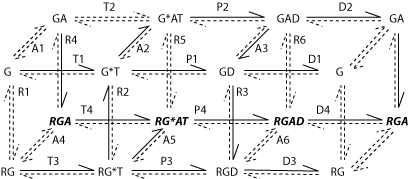Maurya, Bornheimer, Venkatasubramanian, Subramaniam, 2005
Model Status
This CellML model runs in COR and OpenCell and the units are consistent throughout. It reproduces the published results and is representative of the Minimal ROM. Validation was done in both CellML and Matlab, Matlab was used to simulate variations in GAP and R concentrations and to reproduce figure 5C.
Model Structure
ABSTRACT: Biochemical systems embed complex networks and hence development and analysis of their detailed models pose a challenge for computation. Coarse-grained biochemical models, called reduced-order models (ROMs), consisting of essential biochemical mechanisms are more useful for computational analysis and for studying important features of a biochemical network. The authors present a novel method to model-reduction by identifying potentially important parameters using multidimensional sensitivity analysis. A ROM is generated for the GTPase-cycle module of m1 muscarinic acetylcholine receptor, Gq, and regulator of G-protein signalling 4 (a GTPase-activating protein or GAP) starting from a detailed model of 48 reactions. The resulting ROM has only 17 reactions. The ROM suggested that complexes of G-protein coupled receptor (GPCR) and GAP--which were proposed in the detailed model as a hypothesis--are required to fit the experimental data. Models previously published in the literature are also simulated and compared with the ROM. Through this comparison, a minimal ROM, that also requires complexes of GPCR and GAP, with just 15 parameters is generated. The proposed reduced-order modelling methodology is scalable to larger networks and provides a general framework for the reduction of models of biochemical systems.
The original paper reference is cited below:
Reduced-order modelling of biochemical networks: application to the GTPase-cycle signalling module, Mano R. Maurya, Scott J. Bornheimer, Venkat Venkatasubramanian, and Shankar Subramaniam, 2005, IEE Proc.-Syst. Biol, volume 152, 229-242. PubMed ID: 16986265
 |
| Reaction network of the GTPase-cycle module. |

